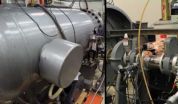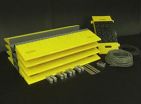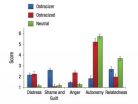(Press-News.org) CAMBRIDGE, MA -- Since the mid-1800s, doctors have used drugs to induce general anesthesia in patients undergoing surgery. Despite their widespread use, little is known about how these drugs create such a profound loss of consciousness.
In a new study that tracked brain activity in human volunteers over a two-hour period as they lost and regained consciousness, researchers from MIT and Massachusetts General Hospital (MGH) have identified distinctive brain patterns associated with different stages of general anesthesia. The findings shed light on how one commonly used anesthesia drug exerts its effects, and could help doctors better monitor patients during surgery and prevent rare cases of patients waking up during operations.
Anesthesiologists now rely on a monitoring system that takes electroencephalogram (EEG) information and combines it into a single number between zero and 100. However, that index actually obscures the information that would be most useful, according to the authors of the new study, which appears in the Proceedings of the National Academy of Sciences the week of March 4.
"When anesthesiologists are taking care of someone in the operating room, they can use the information in this article to make sure that someone is unconscious, and they can have a specific idea of when the person may be regaining consciousness," says senior author Emery Brown, an MIT professor of brain and cognitive sciences and health sciences and technology and an anesthesiologist at MGH.
Lead author of the paper is Patrick Purdon, an instructor of anesthesia at MGH and Harvard Medical School.
Distinctive patterns
Last fall, Purdon, Brown and colleagues published a study of brain activity in epileptic patients as they went under anesthesia. Using electrodes that had been implanted in the patients' brains as part of their treatment for epilepsy, the researchers were able to identify a signature EEG pattern that emerged during anesthesia.
In the new study, the researchers studied healthy volunteers, measuring their brain activity with an array of 64 electrodes attached to the scalp. Not only did they find patterns that appeared to correspond to what they saw in last year's study, they were also able to discern much more detail, because they gave the dose of propofol over a longer period of time and followed subjects until they came out of anesthesia.
While the subjects received propofol, the researchers monitored their responsiveness to sounds. Every four seconds, the subjects heard either a mechanical tone or a word, such as their name. The researchers measured EEG activity throughout the process, as the subjects pressed a button to indicate whether they heard the sound.
As the subjects became less responsive, distinct brain patterns appeared. Early on, when the subjects were just beginning to lose consciousness, the researchers detected an oscillation of brain activity in the low frequency (0.1 to 1 hertz) and alpha frequency (8 to 12 hertz) bands, in the frontal cortex. They also found a specific relationship between the oscillations in those two frequency bands: Alpha oscillations peaked as the low-frequency waves were at their lowest point.
When the brain reached a slightly deeper level of anesthesia, a marked transition occurred: The alpha oscillations flipped so their highest points occurred when the low frequency waves were also peaking.
The researchers believe that these alpha and low-frequency oscillations, which they also detected in last year's study, produce unconsciousness by disrupting normal communication between different brain regions. The oscillations appear to constrain the amount of information that can pass between the frontal cortex and the thalamus, which normally communicate with each other across a very broad frequency band to relay sensory information and control attention.
The oscillations also prevent different parts of the cortex from coordinating with each other. In last year's study, the researchers found that during anesthesia, neurons within small, localized brain regions are active for a few hundred milliseconds, then shut off again for a few hundred milliseconds. This flickering of activity, which creates the slow oscillation pattern, prevents brain regions from communicating normally.
Better anesthesia monitoring
When the researchers began to slowly decrease the dose of propofol, to bring the subjects out of anesthesia, they saw a reversal of the brain activity patterns that appeared when the subjects lost consciousness. A few minutes before regaining consciousness, the alpha oscillations flipped so that they were at their peak when the low-frequency waves were at their lowest point.
"That is the signature that would allow someone to determine if a patient is coming out of anesthesia too early, with this drug," Purdon says.
Cases in which patients regain consciousness during surgery are alarming but very rare, with one or two occurrences in 10,000 operations, Brown says.
"It's not something that we're fighting with every day, but when it does happen, it creates this visceral fear, understandably, in the public. And anesthesiologists don't have a way of responding because we really don't know when you're unconscious," he says. "This is now a solved problem."
Purdon and Brown are now starting a training program for anesthesiologists and residents at MGH to train them to interpret the information necessary to measure depth of anesthesia. That information is available through the EEG monitors that are now used during most operations, Purdon says. Because propofol is the most widely used anesthesia drug, the new findings should prove valuable for most operations.
In follow-up studies, the researchers are now studying the brain activity patterns produced by other anesthesia drugs.
INFORMATION:
The research was funded by the National Institutes of Health, including an NIH Director's Pioneer Award, New Innovator Award and K-Award, and the Harvard Clinical and Translational Science Center.
Written by Anne Trafton, MIT News Office
END
VIDEO:
NASA scientists at the Goddard Cosmic Ice Lab are studying a kind of chemistry almost never found on Earth. The extreme cold, hard vacuum, and high radiation environment of space...
Click here for more information.
Behind locked doors, in a lab built like a bomb shelter, Perry Gerakines makes something ordinary yet truly alien: ice. This isn't the ice of snowflakes or ice cubes. No, this ice needs such intense cold and low pressure to form that the right conditions ...
Back in 2010, the ideas behind a squid's sticky tendrils and Spiderman's super-strong webbing were combined to create a prototype for the first remote device able to stop vehicles in their tracks: the Safe, Quick, Undercarriage Immobilization Device (SQUID). At the push of a button, spiked arms shot out and entangled in a car's axles—bringing a racing vehicle to a screeching halt.*
The need to stop vehicles remotely was identified by the law enforcement community. With funding from Homeland Security's Science & Technology Directorate, and the expertise of the engineers ...
SEATTLE—Researchers used electronic health records to identify Group Health patients who weren't screened regularly for cancer of the colon and rectum—and to encourage them to be screened. This centralized, automated approach doubled these patients' rates of on-time screening—and saved health costs—over two years. The March 5 Annals of Internal Medicine published the randomized controlled trial.
"Screening for colorectal cancer can save lives, by finding cancer early—and even by detecting polyps before cancer starts," said study leader Beverly B. Green, MD, MPH. "But ...
Studied for decades for their essential role in making proteins within cells, several amino acids known as tRNA synthetases were recently found to have an unexpected – and critical – additional role in cancer metastasis in a study conducted collaboratively in the labs of Karen Lounsbury, Ph.D., University of Vermont professor of pharmacology, and Christopher Francklyn, Ph.D., UVM professor of biochemistry. The group determined that threonyl tRNA synthetase (TARS) leads a "double life," functioning as a critical factor regulating a pathway used by invasive cancers to induce ...
VANCOUVER, Wash.—Fishers near marine protected areas end up traveling farther to catch fish but maintain their social and economic well-being, according to a study by fisheries scientists at Washington State University and in Hawaii.
The study, reported in the journal Biological Conservation, is one of the first to look closely at how protected areas in small nearshore fisheries can affect where fishers operate on the ocean and, as a consequence, their livelihood.
"Where MPAs are located in relation to how fishers operate on the seascape is critical to understand for ...
If you think giving someone the cold shoulder inflicts pain only on them, beware. A new study shows that individuals who deliberately shun another person are equally distressed by the experience.
"In real life and in academic studies, we tend to focus on the harm done to victims in cases of social aggression," says co-author Richard Ryan, professor of clinical and social psychology at the University of Rochester. "This study shows that when people bend to pressure to exclude others, they also pay a steep personal cost. Their distress is different from the person excluded, ...
Domestic violence in New Jersey
Article provided by Keith, Winters & Wenning, L.L.C.
Visit us at http://www.kwwlawfirm.com
Everyone thought the story was over. In 2009 pop sensation Rihanna was brutally assaulted by her then boyfriend Chris Brown. The singer stated that she ended the relationship and the media applauded her brave move. She became a role model for domestic violence victims around the world.
That is, until January of 2013 when the star publicly announced that she had rekindled her relationship with her convicted abuser. Unfortunately, Rihanna's ...
Revocable living trust: Is it right for you?
Article provided by Anderson and Associates, P.C.
Visit us at http://www.davidandersonlaw.com/
Most people consider wills for estate planning; however, this is not the only option. In addition to avoiding probate, a revocable living trust may offer you significant before-death and after-death advantages.
In general, a trust involves three parties: the creator, the trustee or trustees (who agree to manage the assets according to the terms of the trust) and the beneficiary or beneficiaries. Something as miniscule as ...
Why borrowing against your 401(k) may be a bad idea
Article provided by Law Offices of Brian Barta
Visit us at http://www.brianbartalaw.com
Twenty-five percent of Americans have made early withdrawals from their retirement plans using a 401(k) loan, according to a recent report by online financial guidance service HelloWallet. However, many people who tap into their retirement funds may do so without being fully aware of the risks involved in doing so.
Particularly in the aftermath of the recent recession, people who borrow against their retirement savings often ...
Changes for teen distracted driving laws in California?
Article provided by Law Offices of Joshua Katz and Bozman-Moss & Watson
Visit us at http://www.sonomalegal.com
One of the most highly-anticipated moments for any teen is when he or she finally receives a driver's license. Once licensed, these drivers no longer have to rely upon mom or dad for transportation. They can go where they want to go, when they want to go there.
However, the freedom that a new driver's license provides requires that teens practice safe driving habits. Even after passing the test, ...



